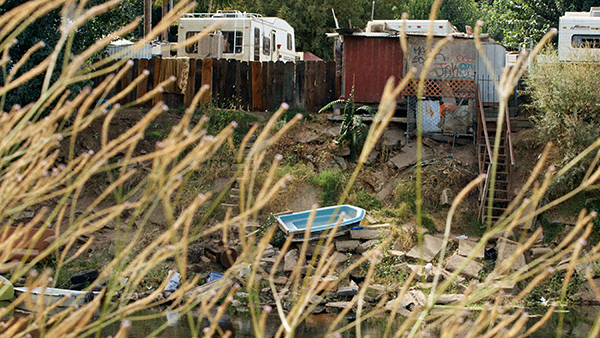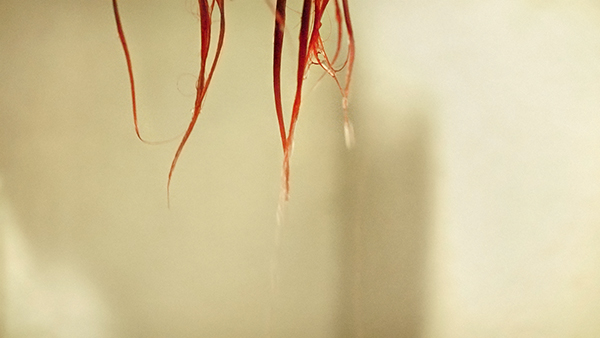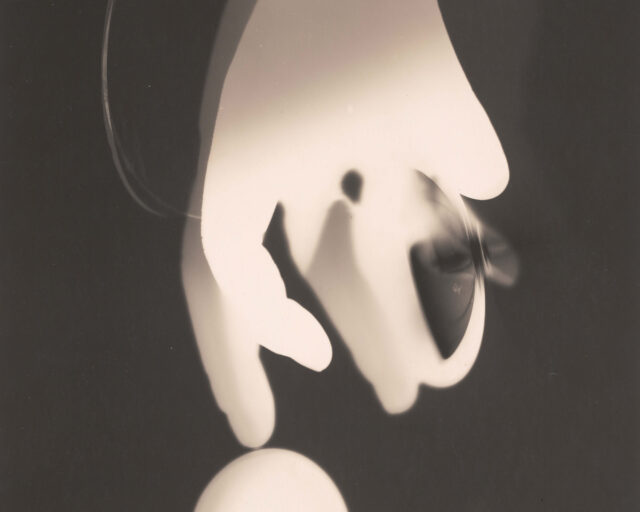In Katy Grannan's First Film, a Story of Poverty in California
An intimate portrait of the neglected Central Valley, The Nine is surprising and urgent.

Katy Grannan, Film Still No. 20 (Wanda, Tears), from The Nine, 2016
Courtesy the artist; Fraenkel Gallery, San Francisco; and Salon 94, New York
At the beginning of photographer Katy Grannan’s first feature film The Nine (2016), the camera peers around a dirty shower curtain. Behind it is Kiki, a black woman with a ragged face, washing her breasts. “The camera sees me every which way,” she observes dispassionately. It’s a disarming moment that sets the tone for this film, a meandering and intimate vérité-style portrait of drifters and junkies living on South Ninth Street—“The Nine”—in Modesto, California. Grannan’s exquisite and authoritative photographic vision provides the film with a surprising beauty, and without falling into tropes of pity or trite aspiration, her depiction of marginalized people makes for a humane and surprising glimpse into lives that don’t often make it to the screen.
Grannan has reluctantly labeled The Nine a documentary, but its genre is vexed. The moods drift through like weather: a brother and sister memorialize their mother by sending silver helium balloons into the sky, and a group discusses a recent murder while a woman in stilettos, lit by car headlights, totters around in the gravel. People play in the river, shoot up, feed the cat, fight, and talk about God, which all adds up to a skillful study of the variety of the everyday—the seamless bleed of often-contradictory experiences that characterize a life.

Katy Grannan, Film Still No. 19 (Blue Boat), from The Nine, 2016
Courtesy the artist; Fraenkel Gallery, San Francisco; and Salon 94, New York
The lives Grannan shows are extreme in their hardship and vulnerability, and the film is concerned with the questions of representation raised by its very existence. Though The Nine includes meta-commentary on the power relations of artmaking, Grannan doesn’t allow the film to become a case study in representational ethics at the expense of focusing on its subjects. At the center is Kiki, who shares a writing credit with Grannan (where her full, legal name, Artimese Fairley, appears for the first and only time). Kiki is in her late thirties and she dreams of being a veterinarian. As a narrator, she is magnetic but unreliable. Her contradictory claims range from her backstory to her drug use; though she no longer speaks to her family, she suggests that her father has promised to buy her a condo. She says she’s clean, but she shoots up on camera in a scene toward the end of the film.
Grannan isn’t concerned with the veracity of these claims, but she is interested in Kiki’s tendency to slip in and out of different realities. “Kiki has fabricated so much,” Grannan told me when I spoke with her last winter. “She’s a master storyteller, but she’s very aware. She has created this shell, this persona, to deflect relationships that she knew would betray her.” Kiki’s signature meld of lucidity and delusion is, in other words, a reaction to dire circumstances. It’s a way to protect herself and control her own narrative.

Katy Grannan, Film Still No. 18 (Kiki Praying), from The Nine, 2016
Courtesy the artist; Fraenkel Gallery, San Francisco; and Salon 94, New York
“I want the viewer to question what they’re seeing,” Grannan said, “whether this is all taking place in Kiki’s imagination—some sort of dream or nightmare state—or if it’s real.” The film’s rambling lyricism mimics Kiki’s reality, and the question of whether The Nine is a dream or nightmare turns out to be a potent one. In a sequence typical of the film’s dissonance, a woman in a cheery blue shirt remarks on her fear of encountering a local criminal: “Even though we’ve got that guy’s picture,” she says, “he could dress up. He’s got one of those faces that he could dress up like somebody.” Grannan then cuts to a woman weaving a flower into another woman’s hair while she confesses her aspiration to open a mud-wrestling club.
These currents of suffering and joy balance the movie and allow it to convey the mood of everyday life rather than only its most pointed moments. The viewer, Grannan said, should “experience the strange way that incredibly ordinary, mundane experiences exist alongside horror,” because witnessing the texture of the characters’ days means that, “You get that there’s a complex history and context for their lives, and you care enough about them to not judge them for whatever they’re doing.”

Katy Grannan, Film Still No. 16 (Purple Eyes), from The Nine, 2016
Courtesy the artist; Fraenkel Gallery, San Francisco; and Salon 94, New York
While Grannan asks viewers not to judge Kiki herself, The Nine’s concern with the presence of the camera in Kiki’s life invites questions about cruelty and exploitation, themes Grannan raises without feigning resolution. Grannan’s exploration of her own entanglement with Kiki’s suffering is made explicit in a moment near the end of the film when Kiki, on her birthday, unravels. After sharing details of her family history, Kiki directly addresses Grannan and her collaborator, Hannah Hughes, telling them that she has revealed parts of herself to them that even her family doesn’t know. Kiki’s biggest fear is that Grannan and Hughes will “leave me and never see me again or you’ll get what you want and … leave.” When Grannan interrupts to try to comfort her, Kiki holds out her hand and commands, “Katy, please hear me out. Please.” She speaks uninterrupted for a while longer, and then concludes, “I don’t want you guys to feel sorry for me. I don’t want anything from you guys, the only thing I want from you guys is … just don’t leave me.”

Katy Grannan, Film Still No. 5 (Dyed Red), from The Nine, 2016
Courtesy the artist; Fraenkel Gallery, San Francisco; and Salon 94, New York
Grannan’s subjects were paid for their time and Kiki, in particular, had control of how she was depicted. It was at Kiki’s insistence, for example, that her vulnerable monologue was included at all. But with that footage, The Nine appears to tacitly acknowledge the long history of white artists distorting their vulnerable subjects and the shared and precarious moral territory of a successful white artist such as Grannan depicting a black woman’s poverty. Grannan is candid about the unresolved ethical questions of her relationship to Kiki; she refuses easy absolution in the form of claims to objectivity, or simplistic ethical formulas, such as “I paid her,” or “she had control.” Instead, The Nine’s open-ended inquiry into whether Grannan’s filmmaking could be causing or distorting Kiki’s pain requires the audience to sit with the complexity of observing another person’s suffering. This is crucial—The Nine would be a manipulative film if it allowed anyone to emerge without questions about how Kiki was depicted and what it meant that they watched.
The nuanced impact of The Nine comes from Kiki’s self-awareness, vulnerability, and her courageous insistence on including the most troubling scenes. Grannan and Kiki are willing to undertake these challenges, in part, I imagine, because of the urgency of the story. People all over the country, and around the world, live precariously. For those of us who are more privileged, Grannan told me, “It’s very convenient to look away, to just pretend none of it exists.”
Read an interview with Katy Grannan in Aperture, Issue 226, “American Destiny.”


























